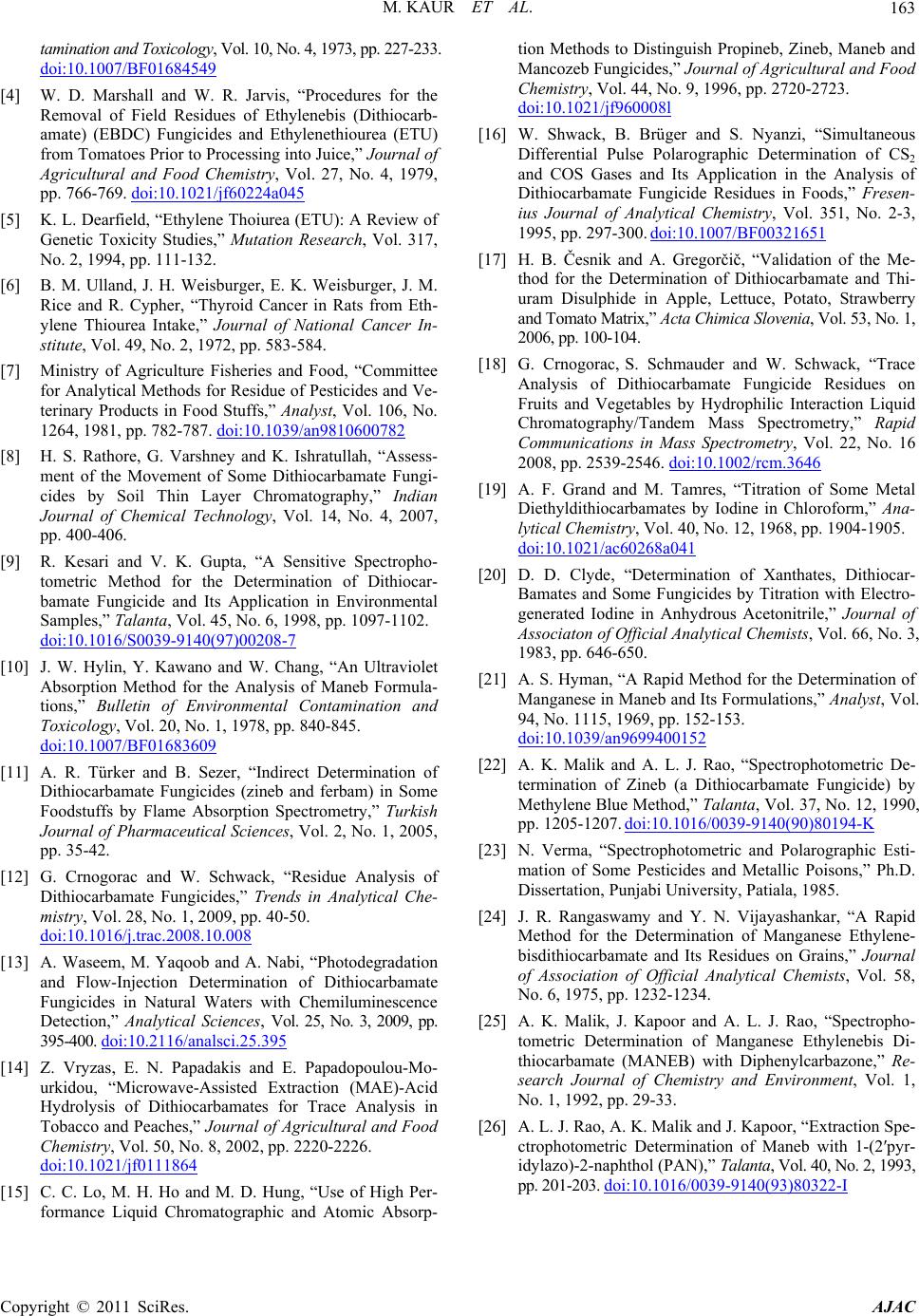
M. KAUR ET AL.163
tamination and Toxicology, Vol. 10, No. 4, 1973, pp. 227-233.
doi:10.1007/BF01684549
[4] W. D. Marshall and W. R. Jarvis, “Procedures for the
Removal of Field Residues of Ethylenebis (Dithiocarb-
amate) (EBDC) Fungicides and Ethylenethiourea (ETU)
from Tomatoes Prior to Processing into Juice,” Journal of
Agricultural and Food Chemistry, Vol. 27, No. 4, 1979,
pp. 766-769. doi:10.1021/jf60224a045
[5] K. L. Dearfield, “Ethylene Thoiurea (ETU): A Review of
Genetic Toxicity Studies,” Mutation Research, Vol. 317,
No. 2, 1994, pp. 111-132.
[6] B. M. Ulland, J. H. Weisburger, E. K. Weisburger, J. M.
Rice and R. Cypher, “Thyroid Cancer in Rats from Eth-
ylene Thiourea Intake,” Journal of National Cancer In-
stitute, Vol. 49, No. 2, 1972, pp. 583-584.
[7] Ministry of Agriculture Fisheries and Food, “Committee
for Analytical Methods for Residue of Pesticides and Ve-
terinary Products in Food Stuffs,” Analyst, Vol. 106, No.
1264, 1981, pp. 782-787. doi:10.1039/an9810600782
[8] H. S. Rathore, G. Varshney and K. Ishratullah, “Assess-
ment of the Movement of Some Dithiocarbamate Fungi-
cides by Soil Thin Layer Chromatography,” Indian
Journal of Chemical Technology, Vol. 14, No. 4, 2007,
pp. 400-406.
[9] R. Kesari and V. K. Gupta, “A Sensitive Spectropho-
tometric Method for the Determination of Dithiocar-
bamate Fungicide and Its Application in Environmental
Samples,” Talanta, Vol. 45, No. 6, 1998, pp. 1097-1102.
doi:10.1016/S0039-9140(97)00208-7
[10] J. W. Hylin, Y. Kawano and W. Chang, “An Ultraviolet
Absorption Method for the Analysis of Maneb Formula-
tions,” Bulletin of Environmental Contamination and
Toxicology, Vol. 20, No. 1, 1978, pp. 840-845.
doi:10.1007/BF01683609
[11] A. R. Türker and B. Sezer, “Indirect Determination of
Dithiocarbamate Fungicides (zineb and ferbam) in Some
Foodstuffs by Flame Absorption Spectrometry,” Turkish
Journal of Pharmaceutical Sciences, Vol. 2, No. 1, 2005,
pp. 35-42.
[12] G. Crnogorac and W. Schwack, “Residue Analysis of
Dithiocarbamate Fungicides,” Trends in Analytical Che-
mistry, Vol. 28, No. 1, 2009, pp. 40-50.
doi:10.1016/j.trac.2008.10.008
[13] A. Waseem, M. Yaqoob and A. Nabi, “Photodegradation
and Flow-Injection Determination of Dithiocarbamate
Fungicides in Natural Waters with Chemiluminescence
Detection,” Analytical Sciences, Vol. 25, No. 3, 2009, pp.
395-400. doi:10.2116/analsci.25.395
[14] Z. Vryzas, E. N. Papadakis and E. Papadopoulou-Mo-
urkidou, “Microwave-Assisted Extraction (MAE)-Acid
Hydrolysis of Dithiocarbamates for Trace Analysis in
Tobacco and Peaches,” Journal of Agricultural and Food
Chemistry, Vol. 50, No. 8, 2002, pp. 2220-2226.
doi:10.1021/jf0111864
[15] C. C. Lo, M. H. Ho and M. D. Hung, “Use of High Per-
formance Liquid Chromatographic and Atomic Absorp-
tion Methods to Distinguish Propineb, Zineb, Maneb and
Mancozeb Fungicides,” Journal of Agricultural and Food
Chemistry, Vol. 44, No. 9, 1996, pp. 2720-2723.
doi:10.1021/jf960008l
[16] W. Shwack, B. Brüger and S. Nyanzi, “Simultaneous
Differential Pulse Polarographic Determination of CS2
and COS Gases and Its Application in the Analysis of
Dithiocarbamate Fungicide Residues in Foods,” Fresen-
ius Journal of Analytical Chemistry, Vol. 351, No. 2-3,
1995, pp. 297-300. doi:10.1007/BF00321651
[17] H. B. Česnik and A. Gregorčič, “Validation of the Me-
thod for the Determination of Dithiocarbamate and Thi-
uram Disulphide in Apple, Lettuce, Potato, Strawberry
and Tomato Matrix,” Acta Chimica Slovenia, Vol. 53, No. 1,
2006, pp. 100-104.
[18] G. Crnogorac, S. Schmauder and W. Schwack, “Trace
Analysis of Dithiocarbamate Fungicide Residues on
Fruits and Vegetables by Hydrophilic Interaction Liquid
Chromatography/Tandem Mass Spectrometry,” Rapid
Communications in Mass Spectrometry, Vol. 22, No. 16
2008, pp. 2539-2546. doi:10.1002/rcm.3646
[19] A. F. Grand and M. Tamres, “Titration of Some Metal
Diethyldithiocarbamates by Iodine in Chloroform,” Ana-
lytical Chemistry, Vol. 40, No. 12, 1968, pp. 1904-1905.
doi:10.1021/ac60268a041
[20] D. D. Clyde, “Determination of Xanthates, Dithiocar-
Bamates and Some Fungicides by Titration with Electro-
generated Iodine in Anhydrous Acetonitrile,” Journal of
Associaton of Official Analytical Chemists, Vol. 66, No. 3,
1983, pp. 646-650.
[21] A. S. Hyman, “A Rapid Method for the Determination of
Manganese in Maneb and Its Formulations,” Analyst, Vol.
94, No. 1115, 1969, pp. 152-153.
doi:10.1039/an9699400152
[22] A. K. Malik and A. L. J. Rao, “Spectrophotometric De-
termination of Zineb (a Dithiocarbamate Fungicide) by
Methylene Blue Method,” Talanta, Vol. 37, No. 12, 1990,
pp. 1205-1207. doi:10.1016/0039-9140(90)80194-K
[23] N. Verma, “Spectrophotometric and Polarographic Esti-
mation of Some Pesticides and Metallic Poisons,” Ph.D.
Dissertation, Punjabi University, Patiala, 1985.
[24] J. R. Rangaswamy and Y. N. Vijayashankar, “A Rapid
Method for the Determination of Manganese Ethylene-
bisdithiocarbamate and Its Residues on Grains,” Journal
of Association of Official Analytical Chemists, Vol. 58,
No. 6, 1975, pp. 1232-1234.
[25] A. K. Malik, J. Kapoor and A. L. J. Rao, “Spectropho-
tometric Determination of Manganese Ethylenebis Di-
thiocarbamate (MANEB) with Diphenylcarbazone,” Re-
search Journal of Chemistry and Environment, Vol. 1,
No. 1, 1992, pp. 29-33.
[26] A. L. J. Rao, A. K. Malik and J. Kapoor, “Extraction Spe-
ctrophotometric Determination of Maneb with 1-(2′pyr-
idylazo)-2-naphthol (PAN),” Talanta, Vol. 40, No. 2, 1993,
pp. 201-203. doi:10.1016/0039-9140(93)80322-I
Copyright © 2011 SciRes. AJAC